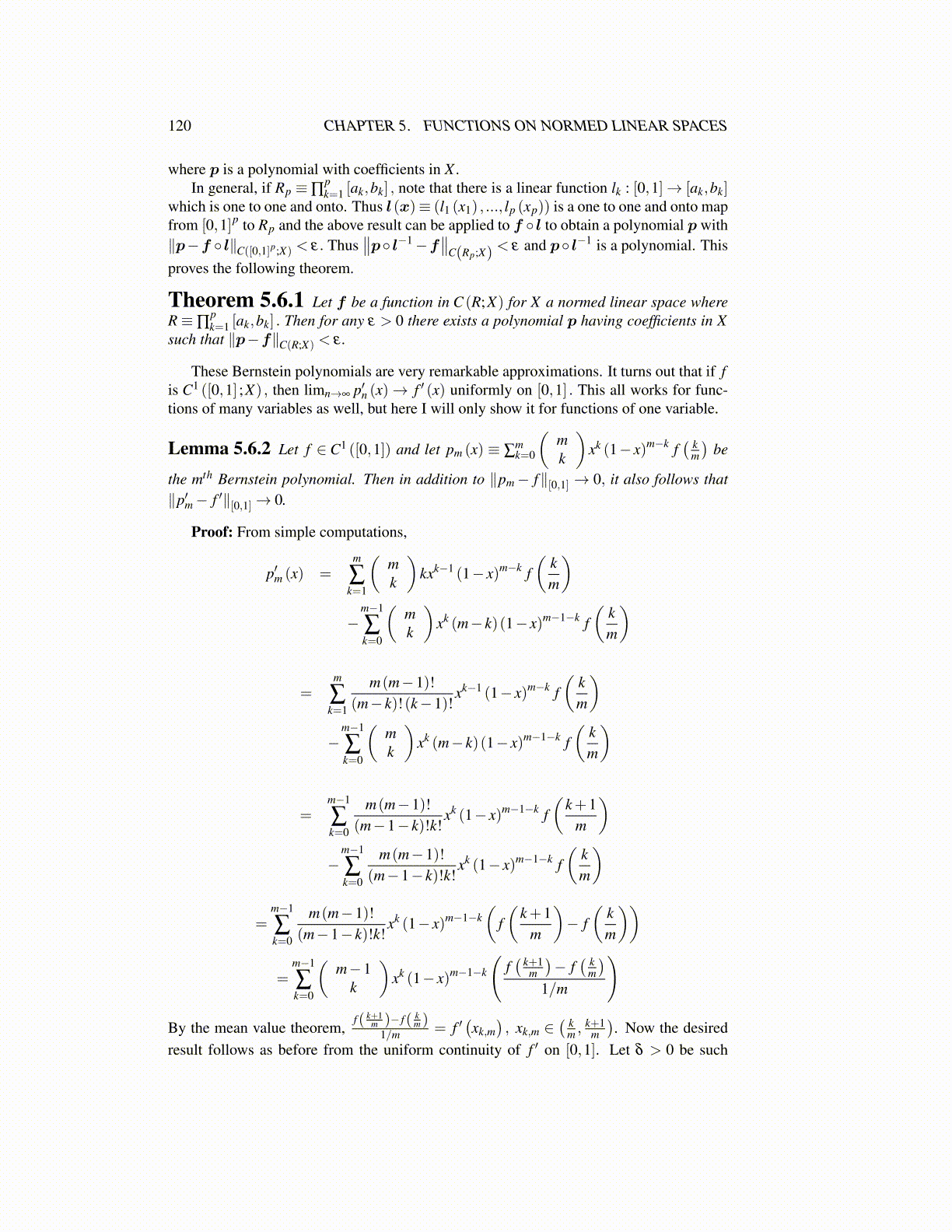
120 CHAPTER 5. FUNCTIONS ON NORMED LINEAR SPACES
where p is a polynomial with coefficients in X .In general, if Rp ≡∏
pk=1 [ak,bk] , note that there is a linear function lk : [0,1]→ [ak,bk]
which is one to one and onto. Thus l (x)≡ (l1 (x1) , ..., lp (xp)) is a one to one and onto mapfrom [0,1]p to Rp and the above result can be applied to f ◦ l to obtain a polynomial p with∥p−f ◦ l∥C([0,1]p;X) < ε. Thus
∥∥p◦ l−1−f∥∥
C(Rp;X) < ε and p◦ l−1 is a polynomial. Thisproves the following theorem.
Theorem 5.6.1 Let f be a function in C (R;X) for X a normed linear space whereR ≡∏
pk=1 [ak,bk] . Then for any ε > 0 there exists a polynomial p having coefficients in X
such that ∥p−f∥C(R;X) < ε .
These Bernstein polynomials are very remarkable approximations. It turns out that if fis C1 ([0,1] ;X) , then limn→∞ p′n (x)→ f ′ (x) uniformly on [0,1] . This all works for func-tions of many variables as well, but here I will only show it for functions of one variable.
Lemma 5.6.2 Let f ∈ C1 ([0,1]) and let pm (x) ≡ ∑mk=0
(mk
)xk (1− x)m−k f
( km
)be
the mth Bernstein polynomial. Then in addition to ∥pm− f∥[0,1] → 0, it also follows that∥p′m− f ′∥[0,1]→ 0.
Proof: From simple computations,
p′m (x) =m
∑k=1
(mk
)kxk−1 (1− x)m−k f
(km
)−
m−1
∑k=0
(mk
)xk (m− k)(1− x)m−1−k f
(km
)
=m
∑k=1
m(m−1)!(m− k)!(k−1)!
xk−1 (1− x)m−k f(
km
)−
m−1
∑k=0
(mk
)xk (m− k)(1− x)m−1−k f
(km
)
=m−1
∑k=0
m(m−1)!(m−1− k)!k!
xk (1− x)m−1−k f(
k+1m
)−
m−1
∑k=0
m(m−1)!(m−1− k)!k!
xk (1− x)m−1−k f(
km
)
=m−1
∑k=0
m(m−1)!(m−1− k)!k!
xk (1− x)m−1−k(
f(
k+1m
)− f
(km
))
=m−1
∑k=0
(m−1
k
)xk (1− x)m−1−k
(f( k+1
m
)− f
( km
)1/m
)
By the mean value theorem,f( k+1
m )− f( km )
1/m = f ′(xk,m), xk,m ∈
( km ,
k+1m
). Now the desired
result follows as before from the uniform continuity of f ′ on [0,1]. Let δ > 0 be such